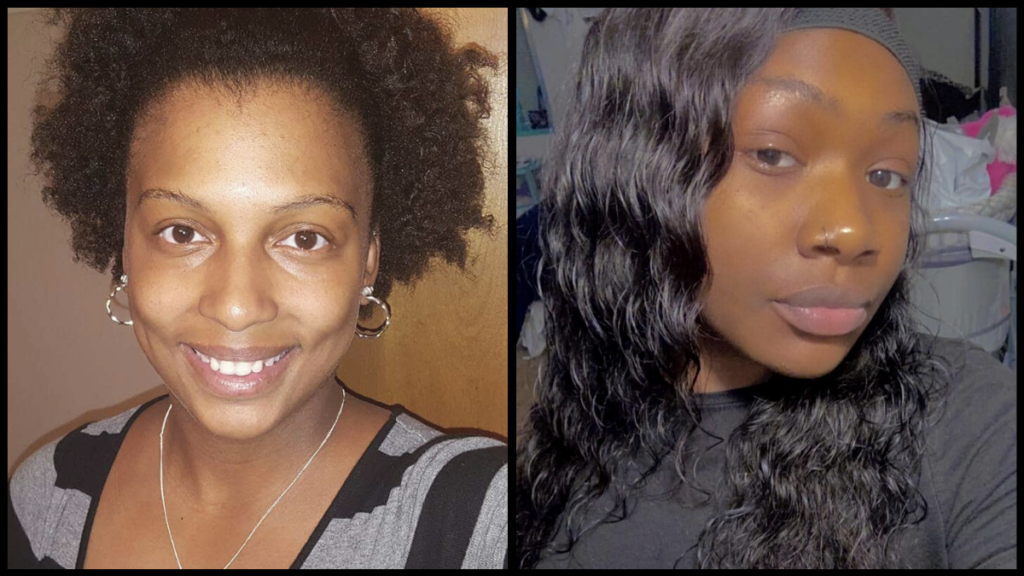By Chrys Collins, RN, MSN Ed, CRRN
Photos given with permission by interviewees

In all transparency, in my mind I knew exactly how I was going to approach the interview process, and I knew exactly what I was going to write. Until the interviews.
I entered my interview process with questions that I hoped would not be leading. I wanted answers that came straight from the heart of each woman rather than questions that might sway them to think or respond in a way that fit my thought process, assumptions, or theories.
I had the pleasure of speaking with Kayla Acosta, Ayana Baugh, Brittany Brown, and Venus Gorham. My goal was to understand as a care provider how I could improve and honestly become more comfortable with my role in the care of all women, no matter their color.
I realize that may sound a little…uh….racist? That isn’t what I mean. What I mean is that sometimes as a white woman I am aware of the racial divide and the disparities that exist, and would like to bridge the gap.
Trust must exist between the women receiving care and those caring for them. I deeply want all women to feel safe and comfortable around me, but I fear offending in some way and losing that trust.
Research verifies the disparities that exist for black women, and there exists a host of theories to explain this cause, but the causes are complex and multifactorial.
Clearly, fixing contributing problems will take time and thorough research as well as behavior changes and self-examination on the part of practitioners.
The questions I asked each woman were the following:
1. Did you have a hospital birth or birth center birth? Elaborate as much as you’d like on the pros and cons of your experience.
2. Were or are there differing needs that you feel Black women have in their care?
3. Can you describe successes or barriers to the following for Black women: peri-partum, postpartum, the delivery process, access to care, natural delivery, and breastfeeding experiences?
MEET KAYLA
I was intrigued during my time with Kayla Acosta. She had both a hospital and birth center birth, so she was able to offer insight for both experiences.
Kayla described her inability to eat and drink in the hospital as well as not being able to birth in the position she felt most comfortable in as a big drawback.
Kayla describes her birth center experiences as much freer since she was able to exercise autonomy and individualism, adding to her comfort and ease.
Kayla’s response to my second question revealed that she didn’t feel that Black women had different needs but needed care that provided unconditional compassion and an environment that allowed for individual needs to be met, as well as encouraged a feeling of safety to voice those needs.
Kayla also pointed out that Black women may “feel the need for more support and extra compassion during and after pregnancy because it is a vulnerable time for a woman.”
Kayla added that, for her, a strong support system (which includes the care provider) acts as a shield to protect from negativity and provides protection from potential mistreatment and discrimination, which she feels is still inevitable.
Kayla also expounded on the need to have a strong advocate to help avoid racism, discrimination and prejudice.
This may seem straightforward but when you think about a woman who prefers a natural birth and she is at 8 cm, in the height of transition, she is in no position to argue with someone for her health care needs.
Kayla is aware of the risks she faces as a pregnant Black woman. Citing an article from The American Journal of Managed Care1 that reports that racism and discrimination can still occur and influence factors that can lead to maternal mortality, the article suggests that health care providers practice self-reflection and work honestly toward behavior change, if necessary, to decrease negative behaviors that may influence outcomes.
One of the most poignant moments of Kayla’s interview was when she described an encounter with a health care provider who told her, “I was afraid you were going to be a difficult patient to work with.”
Kayla admitted to wondering if the practitioner said that because she was Black and being perceived as “the angry Black woman”.
It was here that Kayla added she was not inclined to ever ask if she was being treated a certain way because of her color. Although not quite the same thing, I suddenly remembered moments when I had been treated poorly because I am an assertive woman. I’d never made the connection. Although I don’t want to, I can change being an assertive and possibly irritating woman, but you cannot change the color of your skin.
This statement resonated with me. Whether real or perceived, there is the need yet inability to confirm the origin of such statements despite a certain level of self-protection being needed.
Kayla is certain, though, that self-education and education from family through asking questions empowered her.
She ended the interview with a call to all those in service to not buy into assumed perceptions as well as encouraging providers to “get to know their clients personally”.
MEET AYANA
Ayana surprised me because, admittedly, I have some bias regarding hospital birth. In my mind I thought I was sure to hear some negatives about her pregnancy, birth, and postpartum experience.
Ayana’s birth was a planned hospital birth. She felt very satisfied with her experience and was able to elaborate on the things that made the most impact for her. You might be able to guess some.
Ayana shared that the biggest impacts during her labor were needs that were met specifically for her.
One example she shared was a nurse who stayed with her to offer hands-on support by pressing on her hips during contractions. Ayana felt interventions like this made all the difference for a successful birth.
She was a little disappointed that her own OB/GYN could not be at her delivery and although her own doctor was not there, she was especially grateful that the delivering doctor came to check in on her the next morning.
Family presence was very important to Ayana as well. She felt that having her mother there was vital to her ability to cope.
She did experience a baby with jaundice, and she had to leave her baby at the hospital for light therapy. Ayana found that difficult but “felt complete” when she had her daughter home three days later.
Transparently speaking, I was pleasantly surprised by Ayana’s satisfaction and acceptance of situations that can be challenging during this period of life.
More on that in PART FOUR, though.
References:
1Melillo, G. (2020, June 14). Racial disparities persist in maternal morbidity, mortality and infant health. AJMC.



[…] Read part 3>> […]